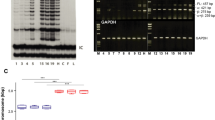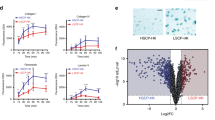Abstract
Fanconi anemia (FA) is a recessive genome instability syndrome characterized by heightened cellular sensitivity to DNA damage, aplastic anemia and cancer susceptibility. Leukemias and squamous cell carcinomas (SCCs) are the most predominant FA-associated cancers, with the latter exhibiting markedly early disease onset and aggressiveness. Although studies of hematopoietic cells derived from FA patients have provided much insight into bone marrow deficiencies and leukemogenesis, molecular transforming events in FA-deficient keratinocytes, which are the cell type of origin for SCC, are poorly understood. We describe here the growth and molecular properties of FANCA-deficient versus FANCA-corrected HPV E6/E7 immortalized keratinocytes in monolayer and organotypic epithelial raft culture. In response to DNA damage, FANCA-deficient patient-derived keratinocyte cultures displayed a G2/M phase arrest, senescence and apoptosis. Organotypic raft cultures exhibited DNA repair-associated defects with more 53BP1 foci and TdT-mediated dNTP nick end labeling-positive cells over their corrected counterparts. Interestingly, together with reduced rates of DNA damage, FA correction resulted in a marked decrease in epithelial thickness and the presence of fewer cell layers. The observed FANCA-mediated suppression of hyperplasia correlated with the detection of fewer cells transiting through the cell cycle in the absence of gross differentiation abnormalities or apoptotic differences. Importantly, the knockdown of either FANCA or FANCD2 in HPV-positive keratinocytes was sufficient for increasing epithelial hyperplasia. Our findings support a new role for FA pathways in the maintenance of differentiation-dependent cell cycle exit, with the implication that FA deficiencies may contribute to the high risk of FA patients for developing HPV-associated SCC.
This is a preview of subscription content, access via your institution
Access options
Subscribe to this journal
Receive 50 print issues and online access
$259.00 per year
only $5.18 per issue
Buy this article
- Purchase on Springer Link
- Instant access to full article PDF
Prices may be subject to local taxes which are calculated during checkout






Similar content being viewed by others
References
Alter BP . (2002). Radiosensitivity in Fanconi's anemia patients. Radiother Oncol 62: 345–347.
Alter BP . (2003). Cancer in Fanconi anemia, 1927–2001. Cancer 97: 425–440.
Bagby GC, Alter BP . (2006). Fanconi anemia. Semin Hematol 43: 147–156.
Bremer M, Schindler D, Gross M, Dork T, Morlot S, Karstens JH . (2003). Fanconi's anemia and clinical radiosensitivity report on two adult patients with locally advanced solid tumors treated by radiotherapy. Strahlenther Onkol 179: 748–753.
Bridge WL, Vandenberg CJ, Franklin RJ, Hiom K . (2005). The BRIP1 helicase functions independently of BRCA1 in the Fanconi anemia pathway for DNA crosslink repair. Nat Genet 37: 953–957.
Chandra S, Levran O, Jurickova I, Maas C, Kapur R, Schindler D et al. (2005). A rapid method for retrovirus-mediated identification of complementation groups in Fanconi anemia patients. Mol Ther 12: 976–984.
Dimri GP, Lee X, Basile G, Acosta M, Scott G, Roskelley C et al. (1995). A biomarker that identifies senescent human cells in culture and in aging skin in vivo. Proc Natl Acad Sci USA 92: 9363–9367.
Dorsman JC, Levitus M, Rockx D, Rooimans MA, Oostra AB, Haitjema A et al. (2007). Identification of the Fanconi anemia complementation group I gene, FANCI. Cell Oncol 29: 211–218.
Duensing S, Munger K . (2004). Mechanisms of genomic instability in human cancer: insights from studies with human papillomavirus oncoproteins. Int J Cancer 109: 157–162.
Garcia-Higuera I, Taniguchi T, Ganesan S, Meyn MS, Timmers C, Hejna J et al. (2001). Interaction of the Fanconi anemia proteins and BRCA1 in a common pathway. Mol Cell 7: 249–262.
Guardiola P, Socie G, Li X, Ribaud P, Devergie A, Esperou H et al. (2004). Acute graft-versus-host disease in patients with Fanconi anemia or acquired aplastic anemia undergoing bone marrow transplantation from HLA-identical sibling donors: risk factors and influence on outcome. Blood 103: 73–77.
Hanenberg H, Batish SD, Pollok KE, Vieten L, Verlander PC, Leurs C et al. (2002). Phenotypic correction of primary Fanconi anemia T cells with retroviral vectors as a diagnostic tool. Exp Hematol 30: 410–420.
Hoskins EE, Gunawardena RW, Habash KB, Wise-Draper TM, Jansen M, Knudsen ES et al. (2008). Coordinate regulation of Fanconi anemia gene expression occurs through the Rb/E2F pathway. Oncogene 27: 4798–4808.
Howlett NG, Taniguchi T, Olson S, Cox B, Waisfisz Q, De Die-Smulders C et al. (2002). Biallelic inactivation of BRCA2 in Fanconi anemia. Science 297: 606–609.
Huyen Y, Zgheib O, Ditullio Jr RA, Gorgoulis VG, Zacharatos P, Petty TJ et al. (2004). Methylated lysine 79 of histone H3 targets 53BP1 to DNA double-strand breaks. Nature 432: 406–411.
Kutler DI, Auerbach AD, Satagopan J, Giampietro PF, Batish SD, Huvos AG et al. (2003a). High incidence of head and neck squamous cell carcinoma in patients with Fanconi anemia. Arch Otolaryngol Head Neck Surg 129: 106–112.
Kutler DI, Singh B, Satagopan J, Batish SD, Berwick M, Giampietro PF et al. (2003b). A 20-year perspective on the International Fanconi Anemia Registry (IFAR). Blood 101: 1249–1256.
Kutler DI, Wreesmann VB, Goberdhan A, Ben-Porat L, Satagopan J, Ngai I et al. (2003c). Human papillomavirus DNA and p53 polymorphisms in squamous cell carcinomas from Fanconi anemia patients. J Natl Cancer Inst 95: 1718–1721.
Levitus M, Waisfisz Q, Godthelp BC, de Vries Y, Hussain S, Wiegant WW et al. (2005). The DNA helicase BRIP1 is defective in Fanconi anemia complementation group J. Nat Genet 37: 934–935.
Longworth MS, Laimins LA . (2004). Pathogenesis of human papillomaviruses in differentiating epithelia. Microbiol Mol Biol Rev 68: 362–372.
Marcou Y, D'Andrea A, Jeggo PA, Plowman PN . (2001). Normal cellular radiosensitivity in an adult Fanconi anaemia patient with marked clinical radiosensitivity. Radiother Oncol 60: 75–79.
Mathew CG . (2006). Fanconi anaemia genes and susceptibility to cancer. Oncogene 25: 5875–5884.
Meetei AR, de Winter JP, Medhurst AL, Wallisch M, Waisfisz Q, van de Vrugt HJ et al. (2003a). A novel ubiquitin ligase is deficient in Fanconi anemia. Nat Genet 35: 165–170.
Meetei AR, Medhurst AL, Ling C, Xue Y, Singh TR, Bier P et al. (2005). A human ortholog of archaeal DNA repair protein Hef is defective in Fanconi anemia complementation group M. Nat Genet 37: 958–963.
Meetei AR, Sechi S, Wallisch M, Yang D, Young MK, Joenje H et al. (2003b). A multiprotein nuclear complex connects Fanconi anemia and Bloom syndrome. Mol Cell Biol 23: 3417–3426.
Montes de Oca R, Andreassen PR, Margossian SP, Gregory RC, Taniguchi T, Wang X et al. (2005). Regulated interaction of the Fanconi anemia protein, FANCD2, with chromatin. Blood 105: 1003–1009.
Nakahara T, Peh WL, Doorbar J, Lee D, Lambert PF . (2005). Human papillomavirus type 16 E1circumflexE4 contributes to multiple facets of the papillomavirus life cycle. J Virol 79: 13150–13165.
Niedernhofer LJ, Lalai AS, Hoeijmakers JH . (2005). Fanconi anemia (cross)linked to DNA repair. Cell 123: 1191–1198.
Pagano G, Degan P, d'Ischia M, Kelly FJ, Nobili B, Pallardo FV et al. (2005). Oxidative stress as a multiple effector in Fanconi anaemia clinical phenotype. Eur J Haematol 75: 93–100.
Rahman N, Seal S, Thompson D, Kelly P, Renwick A, Elliott A et al. (2007). PALB2, which encodes a BRCA2-interacting protein, is a breast cancer susceptibility gene. Nat Genet 39: 165–167.
Reid S, Schindler D, Hanenberg H, Barker K, Hanks S, Kalb R et al. (2006). Biallelic mutations in PALB2 cause Fanconi anemia subtype FA-N and predispose to childhood cancer. Nat Genet 39: 162–164.
Schambach A, Wodrich H, Hildinger M, Bohne J, Krausslich HG, Baum C . (2000). Context dependence of different modules for posttranscriptional enhancement of gene expression from retroviral vectors. Mol Ther 2: 435–445.
Sims AE, Spiteri E, Sims III RJ, Arita AG, Lach FP, Landers T et al. (2007). FANCI is a second monoubiquitinated member of the Fanconi anemia pathway. Nat Struct Mol Biol 14: 564–567.
Smogorzewska A, Matsuoka S, Vinciguerra P, McDonald III ER, Hurov KE, Luo J et al. (2007). Identification of the FANCI protein, a monoubiquitinated FANCD2 paralog required for DNA repair. Cell 129: 289–301.
Spardy N, Duensing A, Charles D, Haines N, Nakahara T, Lambert PF et al. (2007). The human papillomavirus type 16 E7 oncoprotein activates the Fanconi Anemia (FA) pathway and causes accelerated chromosomal instability in FA cells. J Virol 81: 13265–13270.
Tamary H, Alter BP . (2007). Current diagnosis of inherited bone marrow failure syndromes. Pediatr Hematol Oncol 24: 87–99.
Taniguchi T, D'Andrea AD . (2006). Molecular pathogenesis of Fanconi anemia: recent progress. Blood 107: 4223–4233.
Timmers C, Taniguchi T, Hejna J, Reifsteck C, Lucas L, Bruun D et al. (2001). Positional cloning of a novel Fanconi anemia gene, FANCD2. Mol Cell 7: 241–248.
van Zeeburg HJ, Snijders PJ, Joenje H, Brakenhoff RH . (2004). Re: Human papillomavirus DNA and p53 polymorphisms in squamous cell carcinomas from Fanconi anemia patients. J Natl Cancer Inst 96: 968; author reply 968–9.
van Zeeburg HJ, Snijders PJ, Pals G, Hermsen MA, Rooimans MA, Bagby G et al. (2005). Generation and molecular characterization of head and neck squamous cell lines of fanconi anemia patients. Cancer Res 65: 1271–1276.
Wang W . (2007). Emergence of a DNA-damage response network consisting of Fanconi anaemia and BRCA proteins. Nat Rev Genet 8: 735–748.
Acknowledgements
We thank Paul Andreassen, Ruhikanta Meetei, Qishen Pang, James Mulloy, Harmut Geiger, Yi Zheng and Stella Davies for helpful discussions and critical comments on the manuscript. We thank members of the Fanconi Anemia Comprehensive Care Center (FACCC), particularly Lars Wagner, Richard Harris and Robin Mueller for human tissue samples, as well as Susan Radtke for regulatory support. We thank the patients of the FACCC for samples. We are grateful to Denis Lee and Paul Lambert for expert advice on the organotypic raft system, as well as to Maureen Hoatlin for the FANCA and to James Lessard for the monoclonal actin antibody. We thank Christopher Baum for the retroviral SF91 expression vector, and Neeraj Singh for generation of the SF91-18E6/E7 retroviral construct. We thank the flow cytometry core facility and Dan Marmer for assistance with flow sorting. Vector supernatant was provided by the CCHMC Viral Vector Core and Translational Trials Development and Support Lab. This research was supported by Public Health Service Grant CA102357, a grant from the Translational Research Initiative at CCHMC and a grant from the Fanconi Anemia Research Fund to SIW. SD and NS are supported by NIH/NCI R01 CA112598. DAW was supported by Public Health Service Grant HL081499. KAW-B was supported by HL079193.
Author information
Authors and Affiliations
Corresponding author
Rights and permissions
About this article
Cite this article
Hoskins, E., Morris, T., Higginbotham, J. et al. Fanconi anemia deficiency stimulates HPV-associated hyperplastic growth in organotypic epithelial raft culture. Oncogene 28, 674–685 (2009). https://doi.org/10.1038/onc.2008.416
Received:
Revised:
Accepted:
Published:
Issue Date:
DOI: https://doi.org/10.1038/onc.2008.416
Keywords
This article is cited by
-
Proteasomal degradation of p130 facilitate cell cycle deregulation and impairment of cellular differentiation in high-risk Human Papillomavirus 16 and 18 E7 transfected cells
Molecular Biology Reports (2021)
-
DEK promotes HPV-positive and -negative head and neck cancer cell proliferation
Oncogene (2015)
-
High incidence of female reproductive tract cancers in FA-deficient HPV16-transgenic mice correlates with E7’s induction of DNA damage response, an activity mediated by E7’s inactivation of pocket proteins
Oncogene (2014)
-
Rescue of replication failure by Fanconi anaemia proteins
Chromosoma (2012)



